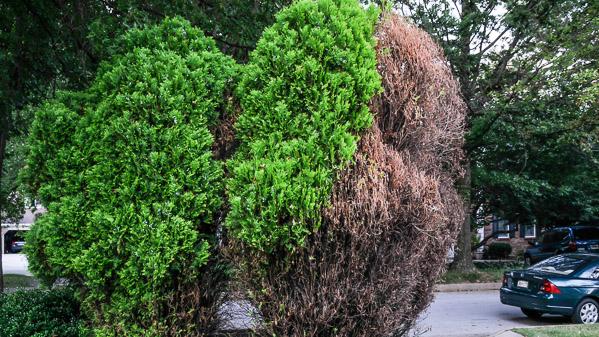Bagworm, Thyridopteryx ephemeraeformis (Haworth), is a serious insect pest of many ornamental shrubs and trees in the eastern half of the United States. Conifers, especially arborvitae, cedar, juniper, and pine are the most frequently damaged host plants.
Deciduous trees such as sycamore, maple, locust, boxelder, and linden are also attacked but they are not seriously damaged. This pest is sometimes confused with Eastern tent caterpillar.
Appearance and habits
- Bagworms are actually the larval or caterpillar stages of moths.
- After hatching, usually sometime in May in central Maryland, they immediately spin a small 1/8 inch long cocoon-like bag to which are attached pieces of leaves from the plants they feed upon. If you look closely, you will see them moving around as they feed on the plant.
- Bagworms move about freely to feed, and they carry their bags with them. The bags gradually enlarge as they feed during the summer to house the growing caterpillar.
- They spread from tree to tree by ballooning (they spin a fine web and use wind currents to infest nearby trees).
Life cycle

- In central Maryland, the eggs hatch sometime in May. Refer to the National Phenology Network's Bagworm Forecast for caterpillar emergence, which is based on Growing Degree Days.
- Bagworms complete their growth in August or early September. At this time, the 1-2 inch long bags are permanently attached to plant twigs by means of tough silken threads.

- In late summer, they pupate inside the bags and then transform into moths, but only the males have wings.

- The males emerge from their bags in late summer and fly to the bags containing females. The males mate with the wingless females which remain in their bags.
- Then each female lays 200 to 1,000 eggs in its bag and dies. The eggs remain in the bags until hatching occurs the following spring.
Damage

- When populations are high, bagworms are serious defoliators of plants. They cause permanent damage to evergreens.
- Shrubs and trees that become heavily infested, particularly conifers, may be killed.
- Injury is not conspicuous early in the season because the caterpillars and their bags are small. The bags are not easily seen at this time unless large numbers are present. Bagworms often are not detected by the untrained observer until August after severe damage has been done.
